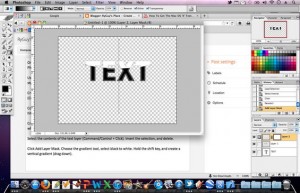Save Room in Your Layers Palette
 This is a quick little tip for keeping your layers palette shorter and more manageable. When you apply a layers style to your layers, each effect is listed separately in the layers palette by default. If you apply five or six effects to one layer, it takes up a ton of room in your palette, and before you know it, you’re scrolling farther and farther down the palette.
This is a quick little tip for keeping your layers palette shorter and more manageable. When you apply a layers style to your layers, each effect is listed separately in the layers palette by default. If you apply five or six effects to one layer, it takes up a ton of room in your palette, and before you know it, you’re scrolling farther and farther down the palette.
To have it take up dramatically less space, collapse the effects in the palette by clicking on the down-facing triangle next to the little "f" icon to the right of the layers name in the Layers palette. You can expand this list of effects anytime by clicking in the same spot.
Speed Up Photoshop By Merging Layers
Every time you add a layer to Photoshop, it adds quite a bit of file size to your image. The larger your file size, the slower Photoshop goes. If youÕre creating a document that has lots of layers, before long, your file size is going to get pretty huge. One way to keep things lean and mean is to merge any layers that donÕt need to be separate. You do this by clicking the topmost layer in the layers palette, and then pressing Command-E. This merges the current layer with the layer directly beneath it. Think of it this way Ð every time you merge two layers, your file size drops and Photoshop gets faster. ItÕs like a keyboard shortcut that adds more horsepower.
Zoom Out For Sharper Web Images
This is a tip we use almost daily when we have to greatly reduce the size and/or resolution of an image. Sometimes when you make drastic size/ resolution change, it can really make the resulting image blurry, so what we do is simply zoom out on the image so that the window and image are at either 50% or 25% view. Then, we take a screen capture of our image window at the new smaller size. That way, the image still looks sharp, but itÕs much smaller when we open the screen capture in Photoshop. The trick to making this work is using either a 50%, 25%, or 12.5% view size for making the capture. If you view the image at 66.7%, 33.3%, 16.7%, the image wonÕt be as crisp (because of the way Photoshop draws the image at those views).
Color-Coding Made Easy
In Photoshop you can color-code layers and layer sets for quick visual identification. One way to do this is to bring up the Layer properties dialog (from the layers paletteÕs pop-up menu) and choose your colors from a pop-up menu. But thereÕs a much faster way Ð at least if you know this shortcut: Control click on the eye icon next to the layer you want to color code, and a pop-up menu of colors will appear where you can choose the shade you like.
Moving Your Image In Full Screen Mode
In Photoshop CS you can pull off something users have been wanting for years Ð the ability to change the placement of your entire image once youÕre in Full Screen Mode (where your image is centered on screen, surrounded by a black border with no menus, palettes, or tools visible). Just enter Full Screen Mode (press f, f, then Tab), hold the Spacebar, and your cursor will change into the Hand tool. Click and drag your entire image anywhere on the screen youÕd like. To return to regular mode, press f then Tab.


No comments
Be the first one to leave a comment.